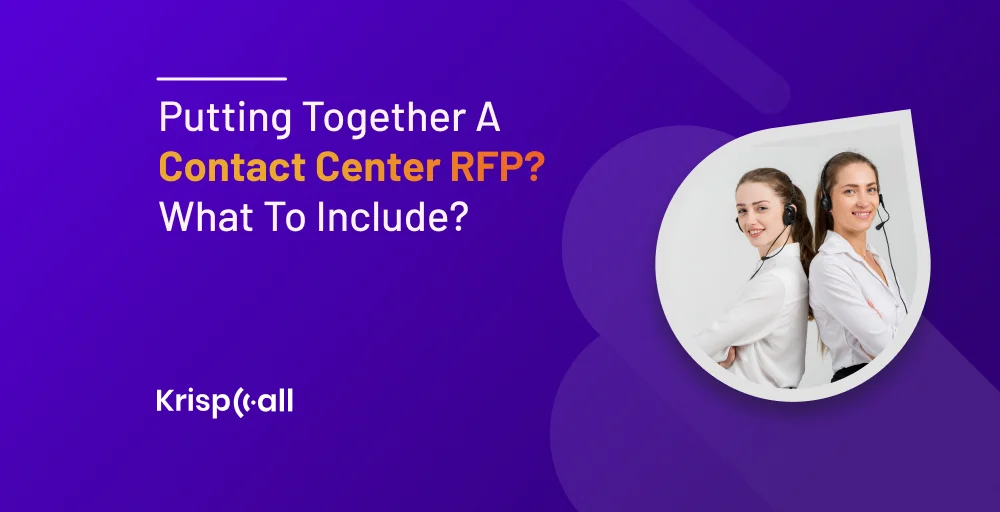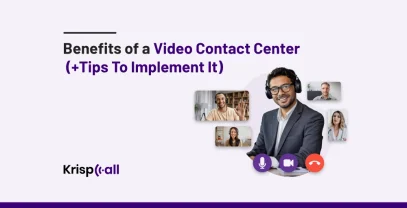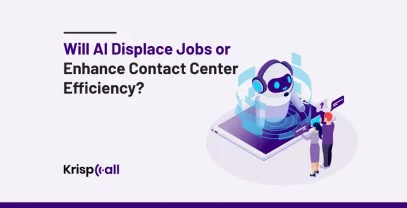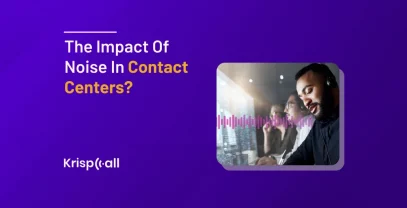Finding the right contact center is always challenging 😞 as a number of providers are available in the market. But now, with the help of a contact center RFP, you can easily choose a provider 😃 that perfectly aligns with your needs and requirements.
A contact RFP, or request for proposal, is a document 🧾 where businesses outline their specific needs and invite vendors to submit offers for a service or project. This makes it much more effortless for you to choose from multiple providers.
➡️ This guide will assist you in crafting an effective RFP by providing information on what to include and key questions to ask in your RFP.
🔑KEY HIGHLIGHT
- A Contact Center Request for Proposal (RFP) involves soliciting proposals from solution providers to meet a company’s contact center requirements.
- Businesses benefit from RFPs by enabling clearer comparisons, reducing risks, and finding the best fit for their needs.
- RFPs help vendors build relationships and understand client needs better.
- Key elements to include in an RFP are telephony usage costs, workforce management (WEM) and AI features, and integration capabilities with existing tools.
- KrispCall is the best option for you to manage your contact center operation seamlessly.
What is a contact center request for a proposal?
A Contact Center Request for Proposal (RFP) is the process of companies asking for proposals from potential contact center solution providers through a formal document. It acts like a navigator for vendors to grasp your expectations by detailing your company’s specific requirements for handling your customer interactions.
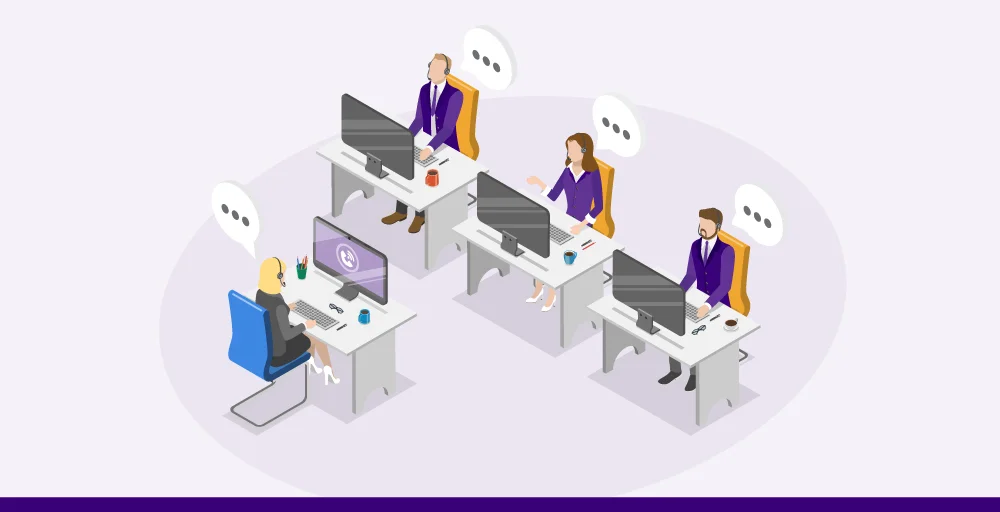
The RFP (Request for Proposal) plays a vital role in finding you the best contact center solution provider for your business needs. By clearly stating your needs, make sure the proposal created by the vendor can really handle your challenges and goals.
With this information, it makes it easier for you to compare the proposal and make a decision on who to work with.
For example, an RFP could request 24/7 email support and phone along with quick resolution and high customer satisfaction ratings. Then, the vendors would define how their contact center solutions and their staff can meet all these requirements.
Benefits of using an RFP for both businesses and vendors
Using an RFP benefits both businesses and vendors in various ways. For businesses, it improves decision-making, transparency and fairness, and clear expectations. On the other hand, for vendors, it helps to standardize processes, clear project scope, and many more.
Besides that, here are the key benefits of using an RFP for both businesses and vendors
The benefits of using an RFP for businesses
- Clearer comparisons: An RFP or Request for Proposal outlines specific criteria for what the business needs. Then you can easily identify the different vendor’s proposals based on the same requirement.
- Reduced risk: A well-crafted RFP provides companies with a clear explanation of their needs. This can help businesses to minimize their chances of misunderstandings or unexpected surprises during the selection process.
- Finding the perfect vendor: Employing an RFP process can help businesses attract more vendors. This increases the chance of getting a contact center that fits your project’s specific needs.
- Stronger contracts: Clearly outlining your needs in the RFP fosters a strong understanding between vendors and businesses. This eventually leads to a smoother contract and project.
- Efficient use of time: By asking the same set of questions to each vendor, businesses can easily compare their proposals, saving time in the evaluation process. This valuable time can be used for more productive tasks.
The benefits of using RFP for vendors
- Targeted efforts: An RFP provides vendors with a clear view of what a company is really looking for. It helps the vendor to focus their proposal efforts on projects that are perfect for their capabilities and experience.
- Showcase expertise: By managing the requirements outlined in an RFP head-on, the vendor can demonstrate how their service can solve the exact issue. This makes clear to businesses why they are the perfect fit.
- Level playing field: A request for a proposal creates a fair and competitive environment and ensures that all the vendors are responding to the same requirements.
- Building relationships: The RFP process can be an opportunity for vendors to build good relationships with potential clients for future projects. Even if they are not chosen.
- Understanding client needs: Vendors can learn a lot about what companies are facing by seeing questions asked by businesses in RFP. This can help vendor how to improve their service.
What to include in a contact center RFP?
Here are the key points to include in a contact center RFP
1. Telephony usage costs
In a contact center RFP, you should briefly describe your current phone usage, including average call volume, peak calling hours, and preferred call routing methods (inbound, outbound, blended). In addition, clearly state your desire for transparent pricing regarding telephony usage costs.
This might include per-minute charges, international call rates, and any additional fees associated with call recording, call forwarding, or other features. Considering these extra costs gives a more accurate view of the total cost of ownership.
2. Workforce management (WEM) and AI features
When creating RFPs, people always focus on fundamental features, and they usually ignore Workforce Management (WEM) and Artificial Intelligence (AI). WEM can help you to improve your agent scheduling and performance.
Similarly, AI can manage your tasks like call routing, sentiment analysis, and simple customer interactions. By stating your interest in these features, vendors can better explain what their contact center solutions can do.
3. Integration with existing tools
A contact center solution should integrate smoothly with your existing CRM, ticketing systems, or other business tools. This allows for data sharing, automated workflows, and a unified customer experience. But failing to manage integration needs in the RFP might result in data silos and worse overall efficiency.
Therefore, you must request information on the contact center provider’s integration capabilities and their experience integrating with similar systems. Then, the vendor can provide information on their integration capabilities with other tools. For example KrispCall integrates tools like Hubspot, Zapier, Piperdrive.
4. Compliance requirements beyond basic security
RFPs usually focus only on general data encryption standards, but security is crucial. So, don’t forget about industry-specific compliance regulations. This could involve encryption protocols, access controls, and regular security audits. For example, if you handle healthcare data, you must have a HIPPA-compliant solution.
Specifying relevant compliance requirements in the RFP ensures vendors understand the regulatory landscape. They operate in and can propose solutions that meet those standards.
5. Call recording access, storage, and destruction policies
Call recording is an effective tool for training, quality control, and conflict settlement. However, RFPs rarely specify call recording practices such as access, storage, and destruction. However, it is essential to provide a document outlining the access rights, storage, and safe disposal of recordings after their use. This ensures ethical data management practices and safeguards customer privacy.
Why create an RFP?
Creating a request for proposal (RFP) can be a valuable step for businesses to discover the perfect vendor for their project or service.
Below here are some benefits of creating a request for proposal:
Standardized comparisons
An RFP creates a clear and consistent set of criteria, that makes it easier for businesses to compare proposals and select the right vendor. An RFP makes sure that everyone knows what you expect and what you need. This helps you to select the best contact center solution provider for your project.
By outlining the project scope, desired features, and evaluation metrics in the RFP, you can easily compare the several vendor proposals. This standardized process will help you to identify between several vendors who offer you the best solution for your needs.
Reduced risk and clear communication
It is crucial to clearly outline your needs in order to create a well-defined request for proposals (RFP). This may help lower the chance of misunderstandings or surprises during the selection process. The RFP encourages potential vendors to address your concerns and demonstrate their capabilities.
By clearly stating your expectations as they relate to your projects, you ensure early and transparent communication, which helps you select a vendor who can meet your needs.
Finding the best fit and building strong contracts
An RFP can help you reach a wide range of providers who can be the perfect vendor for your project. This may help you to discover vendors you may not have considered originally, improving the chance of finding the ideal fit for your project.
The detailed information gathered through RFP responses allows you to assess not just the technical capabilities of vendors but also their background, methodology, and organizational values. Ultimately, a well-crafted RFP helps you choose a vendor who is not only qualified but also best aligned with your overall vision and objectives.
Improved efficiency and time management
Using an RFP approach can make choosing a vendor much easier and save you a lot of time and resources. When all vendors answer the same questions and are judged by the same standards, the process becomes much smoother.
This ultimately may help you to compare proposals and shortlist qualified candidates easily and quickly. Accordingly, this eliminates the essential for lengthy individual meetings and clarifications. This enables a focused concentration on the most promising vendors.
Vendor education and market insights
The Request for Proposal (RFP) process not only helps you to make the selection process much smoother but also advises potential bidders regarding your specific needs and issues. This can result in better-tailored proposals and a better understanding of your industry.
Similarly, examining RFP responses can provide valuable information regarding the present market status and changes in vendor capabilities. You can utilize this knowledge to guide future company decisions and keep you ahead of the competition.
Key questions to include in your contact center RFP
These are the key questions to include in your contact center RFP
What are your reporting and dashboard capabilities
Contact centers and call center supervisors need real-time reporting to streamline operations. This useful tool allows you to monitor incoming call volume, assess the adequacy of customer staffing levels, and gain insight into various aspects of your operations.
Therefore, ask about the types of reports available, the level of customization options, and how data is presented within the dashboards. In addition, the reports and dashboards should be user-friendly and allow you to drill down into specific metrics for deeper insights.
However, when it comes to reports and customization, KrispCall offers a reporting suite featuring customizable dashboards that deliver both real-time and historical data insights. This enables you to effortlessly visualize trends, pinpoint areas for improvement, and gauge the effectiveness of your customer service efforts.
Describe your inbound and outbound voice capabilities
In the contact center RFP, you must include questions about the vendor’s inbound and outbound voice capabilities. This clarifies the vendor’s capacity for handling different types of calls. For inbound calls, you must inquire about features such as call routing, skill-based matching, and IVR systems.
For outbound calls, ask about functionalities for predictive dialing, call blending, and campaign management tools. Before choosing any vendor, ensure that the provider can support your specific call volume and handle both inbound and outbound interactions effectively.
It’s no surprise that KrispCall is the ideal choice for your contact center needs, offering seamless management of both inbound and outbound calls. Its intelligent call routing guarantees that calls are directed to the most suitable agents, while features such as skills-based matching and IVR systems further enhance the efficiency of call handling.
Describe your contact center recording capabilities
Call recording capability is a must-need question in the contact center RFP. This is mostly essential for quality assurance, training purposes, and potential legal requirements. Therefore, it’s essential to ask about vendors recording features such as the ability to record calls, length of storage available, and functionalities for easy retrieval and playback.
This all call recording capabilities are included in KrispCall. This provider offers you extensive call recording features that are meant to help your contact center in a variety of ways.
KrispCall offers you secure storage and simple access to recording. Ultimately, this helps you to improve customer interaction and keeps track of conversations for compliance concerns.
Outline your regulatory compliance standards and any certifications
Data is an important part of any company. To protect this, you must have an extensive range of features. Specify any industry regulations or data privacy laws you need to adhere to (HIPAA, PCI DSS, GDPR).
So, ask vendors to detail their compliance standards relevant certifications they hold, and their overall approach to protecting the data. This ensures your chosen contact center partner operates within legal frameworks and safeguards sensitive customer information.
In securing data, KrispCall is the best option for you as it mainly prioritizes security and regulatory compliance. It provides a wide range of encryption features that perfectly align with data security best practices.
What are your support service fees?
Lastly, consider including support service fees in your contact center RFP. Understanding support fees upfront allows you for a more accurate cost comparison among different vendors. Knowing the full cost picture including ongoing support fees eventually helps you to decide whether a vendor aligns with your budget constraints.
Support services are essential for ensuring the smooth operation of your contact center. Clarifying the fees associated with these services helps determine the overall long-term value proposition of each vendor.
Conclusion
When businesses need to pick a contact center provider, it can be tough. But making an RFP with your needs and wants makes it simpler. Just include things like phone costs, managing your team, linking with your current tools, and compliance requirements.
Then, vendors will submit their proposals on why they’re the best for you. Also, ask about reports, calling features, support costs, and more.
Considering a comprehensive suite of features and reliable service, KrispCall offers everything you need to elevate your contact center operations.
FAQs
What information to include in an RFP?
An RFP should clearly explain your project and selection process to vendors. It usually comprises background information such as budget, project goals, timeframe, and scope of work.
Also, evaluate criteria, and submission rules. This allows the vendors to tailor their offer to your specific needs.
What is the RFP of a contact center?
A request for a proposal for a contact center is a formal document usually used by companies when they need contact center services. It includes explaining your business needs, such as service (internal, external, omnichannel) and desired features.
By issuing an RFP, a company can solicit bids from multiple vendors and compare them. It makes it easier to choose the best fit for their needs.
Where can I find more resources for writing an RFP?
The RFP database provides a knowledge library of compiled RFP data that can be used in future applications. The Chartered Institute of Procurement and Supply (CIPS) and the Institute for Supply Management (ISM) offer a range of resources. In addition, the RFP Process Guide ebook provides an overview of the entire RFP process.
What are some common mistakes to avoid when writing an RFP?
To attract qualified bids, you need to develop a strong RFP. Some mistakes you should avoid such as uncertainty of requirements, inaccurate deadlines, and unclear review processes. If you write a clear and concise text that explains your needs, it can help the client to get a good idea of you.

